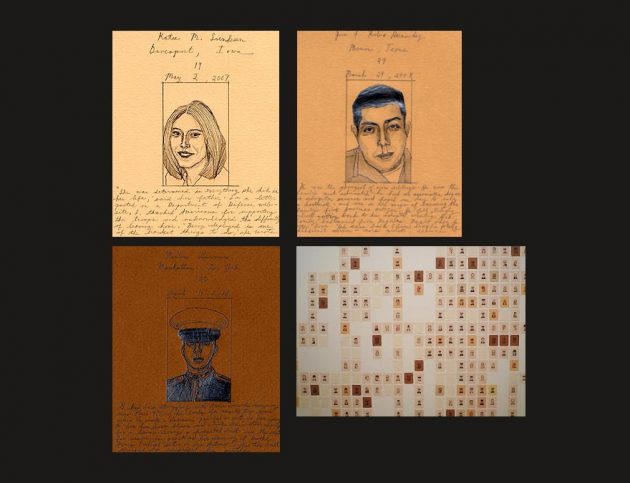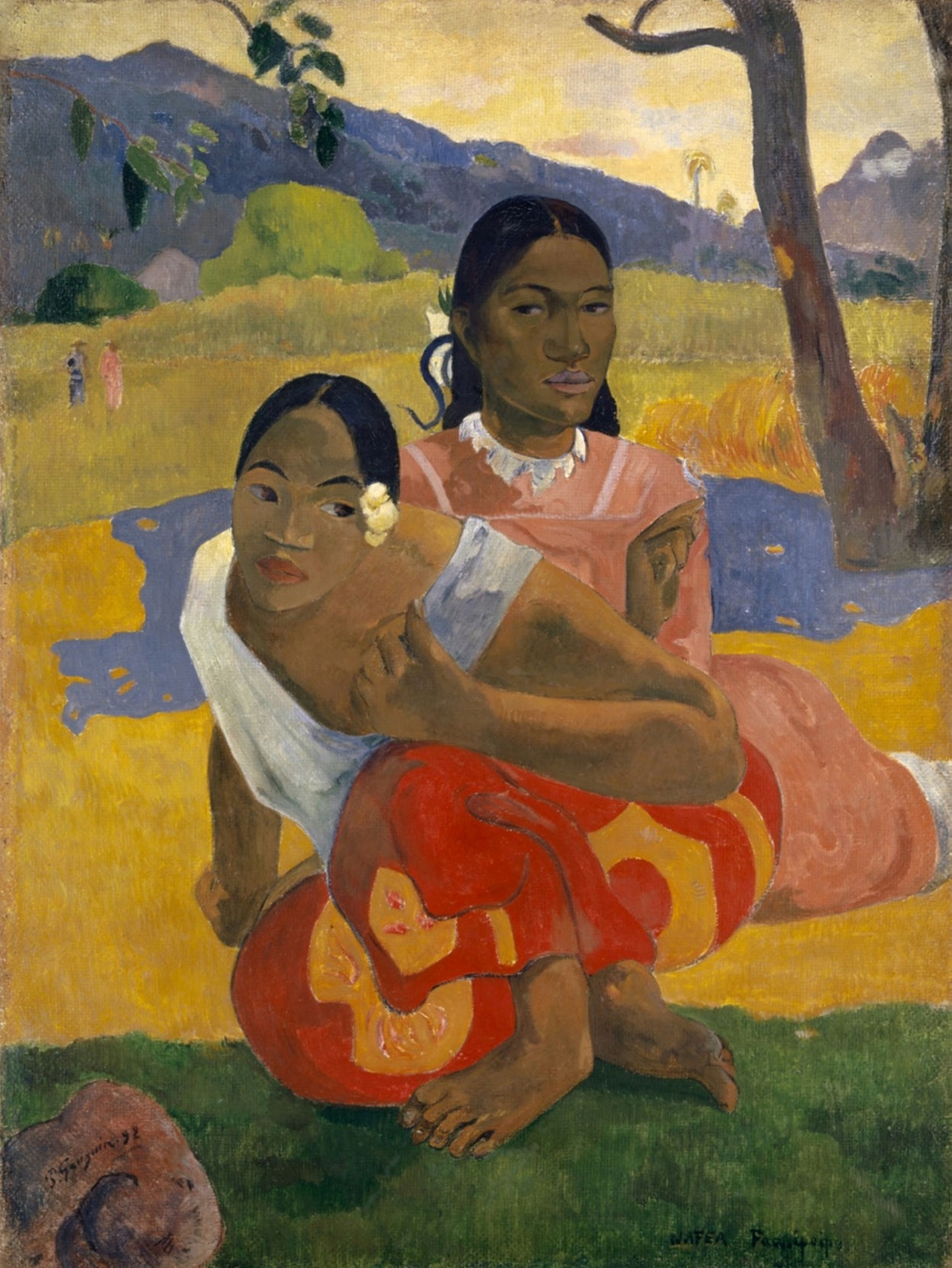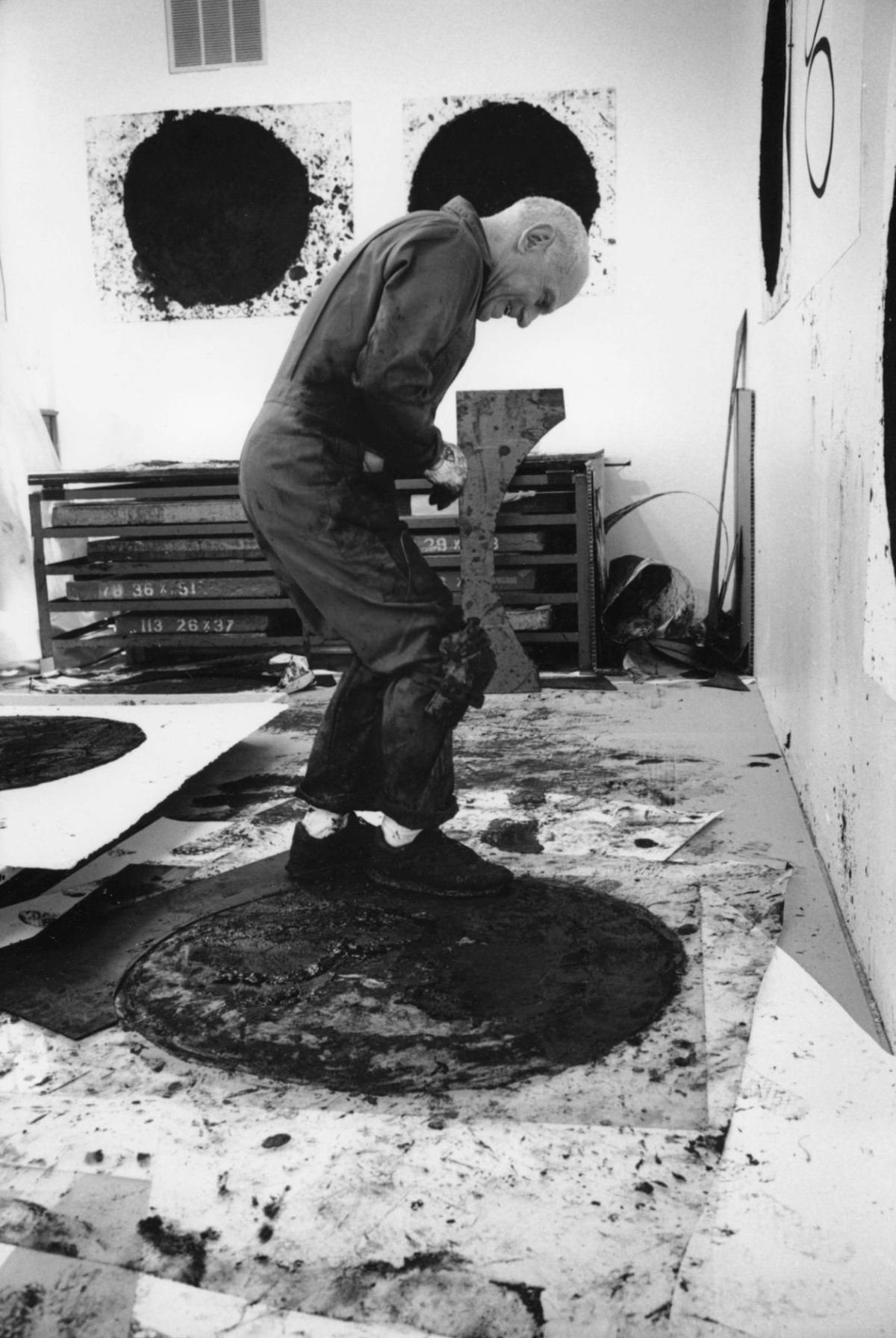Arts


Republished by The Berkshire Eagle, March 9, 2018

Originally published by The Diamondback, February 13, 2018
National Portrait Gallery images
Illustration by Evan Berkowitz/The Diamondback
Similarly, one supposes, when climate change brings the banks of the Potomac up Meridian Hill Park, Kehinde Wiley's newly unveiled portrait of former President Barack Obama will be toted out of the floodplain.


October 6, 2017
Courtesy photo
Admire the scenes of life in mock stained glass surrounding his portrait, and try to emulate the two penitent devotees looking up at him from the left and right panels.
Then, ask of him: “Forgive me, Batman, for I have sinned.”

July 20, 2017
If we all agree on one angle or one fact or one story, does it really matter what that story might obscure or falsify or ignore? In other words, if a critical mass of people say an apple is an orange, doesn’t that become the reality?
These are the heady questions that artist and art historian Sarah Nesbitt explores, but does not answer in her first-ever solo show, a superb but difficult offering that opened at the Torpedo Factory’s Target Gallery July 13.
It’s all very night-is-day and black-is-white, and while Nesbitt may not have meant to go so “1984,” we’re lucky that she did.

July 13, 2017
Nothing at all is absolute, and everything in a given scene becomes warm, gyrating between swirls of orange and hot white in the highlights and humming magenta or purple in the shadows.
“It’s sort of what I see,” she said. “The light was warm, so I just pushed it further.” It’s almost, one could begin to hazard, Impressionistic — but don’t let Davies catch you saying that.


May 30, 2017
The women were very clear prototypes, Davis says, with few ever individualized. Beyond that, these depictions masked a far darker reality, one addressed in the exhibition’s final gallery.
“We wanted to have a kind of homage to those women who actually worked in those quarters,” Davis explains. The exhibition leaves visitors not with paintings of the women frolicking about the floating world but a photograph of them locked in a cage.


April 13, 2017
Double-byline with John Barrat
“In Fallujah, he was this tobacco-chewin’ hard-ass Marine, scout sniper, the whole thing,” says Gilbertson, whose photo of Bosselmann’s bedroom is on view as part of “The Face of Battle: Americans at War, 9/11 to Now,” which opened April 7 at the Smithsonian’s National Portrait Gallery. “All the ideas you have about the hard-core Marine, he was it.”
But when Gilbertson entered Bosselmann’s bedroom after the Montgomery County, Md., resident was killed in combat in 2004 at age 21, he saw another side of the soldier.
“There are stuffed animals, like foxes, on his bed, because he loved fox hunting,” Gilbertson recalls, eyeing his photographs at a press preview April 6. “On his bookshelf, there were Shakespeare plays, and he would come into D.C. as often as he could to go and see productions of Shakespeare.”
“There’s no way I would have guessed that when I saw this dude chewing and spitting tobacco and shooting people out of a window,” Gilbertson says, “that I would have imagined that he loved Shakespeare, running through the house in his underpants to get a possum that he had shot from his bedroom window."


March 9, 2017
“It wasn’t until 10 years ago,” Watanabe says, “when I went to the basement of the house, helping to clean things out after my dad died [that] I realized, ‘Look at the number and the tag on it: That’s the camp. … This was grandma’s suitcase that she took to the camp.’”

February 27, 2017


February 21, 2017
Photo courtesy of the Hirshhorn Museum and Sculpture Garden/Courtesy of Ota Fine Arts, Tokyo/Singapore; Victoria Miro, London; David Zwirner, New York/(c) Yayoi Kusama


February 15, 2017
Martha Hamilton, a nurse informaticist by day, has worked as a sculptor’s assistant and says she felt “really comfortable helping someone else bring their vision to reality.”
“It was very liberating, because it’s not about me at all,” she says. “And even when they talked about my age, it didn’t really bum me out a ton. It was just like, ‘OK, well you notice that.’”
“Because it’s not Martha…up there,” Hamilton says. “I’m not Martha. I’m ‘Woman in E.’”


January 23, 2017
Courtesy photo
Through her we can begin to see Corcoran’s genius, and through her travels we are afforded a unique view on the inner politics of Washington curators, from the mid-19th century to the present.


October 28, 2016
Varying diameters of the blown-glass forms signify fluctuating populations over time, their opacities indicate the relative quality of that data and their colors signify a general ranges of age.
A few key hints guide museumgoers down the path to understanding, but as far as Viviano is concerned, it doesn’t really matter if they ‘get it’ or not.
“I honestly think that most people walk into the gallery and have no idea what that project is,” Viviano says. “That’s fine.”

September 13, 2016
Photo courtesy of the Renwick Gallery/Collection of Norwood Viviano, courtesy of Heller Gallery, New York/Photo by Tim Thayer/Robert Hensleigh, courtesy of Heller Gallery


July 6, 2016
Image courtesy of the National Building Museum


June 29, 2016
Image courtesy of the National Gallery of Art/Musee d'Art Moderne Andre Malraux, Le Havre
Perhaps this is an allegory to the lost, classical past. Perhaps this is a story of the Revolution, which took so many cultural treasures as collateral. Perhaps, even, it is an optimistic view that even should the Louvre's walls fall, artists will still create things.
Whatever it is, it is Robert's startling, stunning reminder, to himself more than anyone, that tempus fugit, and even in Arcadia, death persists.

May 8, 2016
Strip away the incidental characters who crowd out that moral, leaving only the music and their messages to inform rather than distract us.
Strip away the costumes, leaving all in black — if allowing for a ruffled dress and that Maryland flag bowtie.
Clear away the clutter of tertiary characters, to the purest of music.
After all, it's Mozart, and it works spectacularly.

May 8, 2016
The deepest pity is that it was only performed once.


April 10, 2016
Photo courtesy of Jeremy Daniel
But if you want something a little more erudite and functionally useless, here you are:
What the hell is up with the background lighting?!


March 30, 2016
Image courtesy of the National Gallery of Art/© 2016 The Andy Warhol Foundation for the Visual Arts, Inc./Artists Rights Society, New York


March 9, 2016
Photo courtesy of Turquoise Mountain/Freer|Sackler Gallery

March 2, 2016
...
It's an extraordinarily nuanced and capable negotiation for an artwork by a high school student, and the painting quality is not bad either. So it is with much of the works, all produced by high school students in Kansas City, Mo.

February 5, 2016
From the veritable sculpture garden that beckons visitors in from her treelined residential street to the cleverly self-conscious food-themed works in the kitchen, each surface is covered, each wall occupied and each artwork — with few notable exceptions — is remarkable. The house is chock-full of eclectica, most of it beautiful and much of it extremely prescient.
And, of course, it's all for sale.

February 5, 2016


October 25, 2015
Image courtesy of the Smithsonian American Art Museum
“This whole thing is pretty dynamite. And we want you to see it all.”


October 21, 2015
Photo courtesy of the National Building Museum
But give an architect a curator’s job and — as evidenced by a superbly executed new show at the National Building Museum — you get something truly noteworthy.
In the heart of this utterly geometric Washington landmark, “The New American Garden,” which opened Saturday, presents a welcome respite of the undulating Romantic.


October 14, 2015
Image courtesy of the Phillips Collection
How fitting, then, that the first Phillips exhibition to open since the announcement chronicles partnerships as well.


October 8, 2015
Photo courtesy of the National Museum of American History
As far as nicknames go, I think I’d take George E. Ohr’s any day.


Award Watch
This article was selected as a finalist in the 2016 DC Student Arts Journalism Challenge, an annual competition designed to identify and support talented young arts writers, held by Day Eight and Burgeon Online magazine.
October 4, 2015
Image courtesy of the National Gallery of Art/Photo by Sidney B. Felsen
“That’s Richard Serra stomping on it, while he’s developing a piece,” Felsen said, gesturing to a photograph of the famed sculptor tramping on a paintstick print at the Los Angeles studios of Gemini Graphic Editions Limited, which Felsen co-founded almost fifty years ago. “Actually, he’s dancing to it, is what it is. There’s music playing, and he’s jumping on it so he can get some texture.”
Speaking in a tired but assured monotone at a National Gallery of Art press preview last week, Felsen looked exactly how one expects such a consummate patron of the arts to look. He wore a pinstriped seersucker suit, Panama hat, salt-and-pepper beard, bowtie and scarf with the panache few people can pull off nowadays.
He seemed like somebody forged in a hugely interesting past but intent on unabashedly existing in the present. So it is with much of the modern art on view in this 17-artist show, which opened Sunday. The works interplay with the artists of old, but manage to look exciting and new at the same time.
And so it is with Gemini G.E.L. itself, which since 1966 has managed to evolve and innovate rather than drift into stagnation. This progress was shown by the new generation of Gemini leaders present at the preview, as well as the fact that, though this is the National Gallery’s fourth Gemini-centric show, it still manages to craft new angles on beloved artworks.


September 29, 2015
Photo courtesy of the National Museum of African Art
Stanley is casually referring to the “Hell” section of “The Divine Comedy,” a fantastic exhibition also currently on view at the National Museum of African Art. The entrance to “Artists’ Books,” which Stanley curated, is just inside the “Hell” section.
With thought, though, her words carry a little more weight and echo in the mind as Stanley describes the intricacies of each of the 25 artists’ books on view. To create the amazingly innovative and beautiful works, the artists in some cases had to endure or portray unbridled pain and hardship, either personally or ethnically. In a way, to create the stunning works in this exhibition, they had to go through hell.


September 28, 2015
Photo by Julia Lerner/For The Diamondback

September 17, 2015
Print only

September 15, 2015


September 9, 2015
Image courtesy of the Smithsonian American Art Museum/Corbin-Henderson Collection/Gift of Alice H. Rossin


September 7, 2015
Image courtesy of the Hirshhorn Museum and Sculpture Garden
Hold up a hand about four feet in front of it, though, and the piece (along with its wordplay title) comes into view. The projector is shining the word “visibile” (“visible” in Italian) in block letters of light. The artwork remains invisible until museumgoers actively try to see it.

May 27, 2015
These big names are most likely there to draw visitors in but once museumgoers get a look at what’s inside, the need for flashiness dissolves. If you did still need it, there are satisfying works by Raphael, Sandro Botticelli and Rembrandt Van Rijn among others.


May 26, 2015
Image courtesy of the National Gallery of Art
It’s relatively replicable nature along with its technological implications raises questions about how we constitute artmaking and what we consider art, from early daguerreotypes, an early type of photograph, to Instagram posts.


April 18, 2015
Image courtesy of the Smithsonian
Working from sketches drawn during sessions with Kennedy before his death, de Kooning told LIFE magazine she “produced hundreds of sketches and 23 finished paintings” of the president.
Nine of those Kennedy paintings and drawings are on view, along with 57 other de Kooning works, in a new exhibition, which opened March 13, at the National Portrait Gallery.


April 15, 2015
Image courtesy of the Smithsonian American Art Museum
A new exhibition on the 20th century Japanese-American modernist’s work opened April 3 at the Smithsonian American Art Museum. Curated by Tom Wolf, an art history professor at Bard College and museum deputy chief curator Joann Moser, the exhibit chronicles Kuniyoshi’s changing work from 1918 to 1953, the first such U.S. retrospective in more than 65 years, according to a museum press release.

May 27, 2015
The video, part of an exhibit at The Kennedy Center, starts with an elegant, nondescript urn. Picasso bends the clay a few times at the neck, mouth and bottom. He scores it quickly without hesitation using a wooden tool, gives it a few dabs of black paint and reveals a dove etched in clay.
It is the purest of art, and the speed Picasso executes his craft reinforces the mastery.
Here was a man who had an impeccable eye and who knew how to make the clay do exactly as he wanted.
